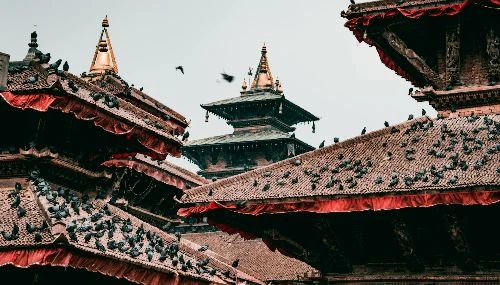The best time to visit Bhutan is during spring (March and April) and autumn (October and November). Many travel to Bhutan especially for trekking and festivals. So each season is packed with either trekking adventures or festival celebrations.
However, October is hands down the best month to visit Bhutan. The weather is just right, not too hot, not too cold and the skies are usually clear, ideal for sightseeing and trekking.
Plus, October is festival season, so you’ll get to see some of Bhutan’s most colorful and lively celebrations. But because it’s so popular, you might find more tourists around, especially at the main attractions. Still, there are plenty of quieter spots.
If you prefer a quieter experience, consider visiting in February or March. The lower regions, like the Punakha Valley, start warming up, and you can enjoy festivals like the Punakha Drubchen without the crowds. The higher valleys might still have some snow, but it’s a lovely time to visit if you want to enjoy Bhutan’s beauty without too many people around.
Spring is an incredible time to visit if you’re into nature and flowers. From mid-March to May, the weather is warm and pleasant, and the hills are alive with various colors of rhododendrons. April is a great month because you can also catch the famous Paro Tsechu festival, where you’ll see traditional masked dances. Trekking is popular in spring, but keep in mind that there might be a bit of rain, and the trails can get muddy.
Furthermore, November is perfect for birdwatchers. You get to see the black-necked cranes. These beautiful birds migrate to the Phobjikha Valley for the winter, and it’s a great time to see them before the weather gets too cold. The temperatures are cooler, and you won’t find as many tourists around. It’s a peaceful time to explore Bhutan. Just be sure to pack warm clothes because it can get chilly, especially in the higher altitudes.
Likewise, July is for the flower lovers. July falls in the monsoon season, so it’s not the most popular time to visit. The rain can make roads tricky and the mountain views cloudy. But if you’re a fan of wildflowers, this is your month. The alpine valleys are filled with blooms, including the rare blue poppy. Plus, it’s mushroom season, and there are some local festivals in the less-visited areas like the Haa Valley.
When it's winter in Bhutan, from January to February, it gets pretty quiet and cold. But if you don’t mind the cold, it’s actually a great time to explore without the usual tourist crowds. The high mountain passes are all covered in snow, but the main valleys remain accessible. Just remember to pack plenty of warm clothing and you'll be good to go!
Seasons, Weather Conditions, and Temperatures in Bhutan
Bhutan experiences four different seasons throughout the year.
- Spring (March to May)
- Summer (June to August)
- Autumn (September to November)
- Winter (December to February)
Spring in Bhutan
Spring in Bhutan is a magical time, though it’s fairly short, usually lasting from early March to mid-April, before the summer rains start. During these months, the weather is mild, with daytime temperatures reaching up to 21℃ (70℉) in Thimphu and 25℃ (77℉) in Punakha. The snow begins to melt and there will be a stunning display of wildflowers on hillsides, while the air remains fresh and humidity is low.
March and April are particularly pleasant, with the best weather conditions of the season. However, as May approaches, temperatures start to rise, and the air becomes a bit more humid. While rhododendrons and other flowers are still in bloom, the weather can turn cloudy in May.
One of the highlights of visiting Bhutan in spring is the crystal-clear views of the Himalayas. The skies are usually clear, and you’ll see breathtaking panoramas, especially from higher elevations.
For nature lovers, late April to May is an ideal time to visit. Bhutan's valleys come alive with beautiful flowers, including magnolias, jacarandas, foxgloves, cosmos, hydrangeas, Himalayan poppies, and lilies. The rhododendrons are the stars of the show, often covering entire hillsides in various colors. If you find yourself in Punakha in mid-May, don’t miss the jacaranda trees at Punakha Dzong, which bloom in a stunning purple display.
Spring in Bhutan is also a time for cultural festivities. The Gomkora festival in Trashigang is one such event, known for its religious dances and deep cultural significance. In early April, the Paro Tshechu takes place where you get to experience Bhutanese culture through unique masked dances and traditional music. You might even spot the King of Bhutan, who often attends the Paro Tshechu.
For those seeking adventure, spring is the time to go on treks like the Jomolhari Trek and Drukpath Trek. These treks are best from mid-April to the end of May. Also, if you’re interested in wildlife, spring is the best time for birdwatching in Bhutan, especially in the subtropical forests. The variety of birds and the lush surroundings make it a haven for nature enthusiasts.
Summer in Bhutan
Summer in Bhutan is a long and lively season, starting in mid-April and stretching all the way to mid-September. This is when the country experiences the most rainfall, especially from late June onwards. These rains are most intense in the southern parts of Bhutan and turn the valleys and forests into lush, green landscapes. However, the monsoons can also cause flash floods, which might affect rural areas, road travel, and even domestic flights.
The weather in summer is warm and humid, with July being the hottest month. In the east, temperatures can climb up to 31.5°C, while in Thimphu, the capital, it usually stays around 26°C. Even though the days can be quite warm, nights can still be cool, especially in the northern regions.
Summer is also a time of celebration in Bhutan. In June, you can experience the colorful Nimalung Tshechu, a festival full of traditional dance, music, and vibrant costumes. Later in June, the Kurjey Tshechu takes place at the sacred Kurjey Lhakhang. This festival is particularly special because it honors Guru Rinpoche, an important figure in Bhutanese Buddhism.
If you love nature, summer is the best time to visit Bhutan. The valleys and forests are especially lush and green, thanks to the monsoon rains. The Phobjikha Valley, known for its stunning scenery, is a must-see. If you visit towards the end of summer, you might even spot the rare black-necked cranes that make this valley their home.
For adventure seekers, summer in Bhutan offers some exciting opportunities. You can go river rafting on the Mo Chhu or Pho Chhu rivers, where you’ll experience both calm stretches of water and thrilling rapids. Likewise, if you’re into trekking, summer is a good time to explore lower-altitude areas like the Bumthang Cultural Trek. This trek is more accessible during the warmer months and you get to experience Bhutan’s rich culture and beautiful landscapes.
Summer is also a great time to enjoy Bhutanese cuisine. The markets are full of fresh, seasonal produce, which makes its way into local dishes. You can even take part in cooking classes to learn how to make traditional Bhutanese meals yourself.
One of the best things about visiting Bhutan in the summer is that there are fewer tourists, so you can enjoy the country’s beauty in peace. The lush green landscapes and breathtaking rivers make Bhutan especially beautiful during this season.
If you’re planning to visit Bhutan in the summer, early June is a good time to go, before the heavier rains begin. Keep in mind that some remote areas, like Gangtey, might be harder to reach because of muddy roads. It’s a good idea to check local travel updates and make sure you pack waterproof clothing for those rainy days.
Autumn in Bhutan
Autumn in Bhutan is a truly special time. As the summer monsoon rains fade away, late September or early October marks the beginning of a season with clear skies and breathtaking scenery. The weather is just perfect–bright, sunny days that are ideal for outdoor activities like hiking and trekking. The views of the Himalayas are stunning, with the snow-capped peaks in blue sky. In the higher regions, you might even see some early snowfall as the season goes on.
The average temperatures during this time range from 15°C to 22°C, making it comfortable for outdoor activities and exploration.
Autumn is also the peak festival season in Bhutan. One of the biggest highlights is the Thimphu Tshechu, a three-day religious festival held in the capital, featuring traditional masked dances, folksongs, and music played on instruments like cymbals, flutes, and yak-horns.
There’s also the Wangdue Phodrang Tshechu, which happens around the same time as the Thimphu Tshechu, giving you a chance to experience two major celebrations in one trip. Then there’s the Jambay Lhakhang Drup in October, known for its unique fire ceremony and mystical dances.
In addition to the festivals, autumn is when around 50 species of migratory birds, including the rare black-necked cranes, start arriving in Bhutan from northern Tibet and Mongolia. These birds are celebrated during the Black-necked Crane Festival on November 12, a must-see if you’re in the country at that time.
Not to mention, the autumn months are also perfect for exploring Bhutan's stunning landscapes. The Phobjikha Valley, often called the Switzerland of Asia, is especially breathtaking with its mix of wildlife and scenic beauty.
However, autumn is the busiest tourist season in Bhutan, particularly in October. Popular sites and festivals can get crowded, so it’s a good idea to balance your itinerary with some off-the-beaten-path destinations to fully appreciate the charm of Bhutan.
Since it’s peak season, hotels and guides can get fully booked quickly, especially during the festivals. Make sure to book early to secure your spot. And don’t forget to pack smart, layering is your best friend in Bhutan, as the temperatures can vary throughout the day.
Winter in Bhutan
Winter in Bhutan, running from late November to early March, is a time of serene beauty. When the weather gets colder and the snow starts falling, the higher regions of Bhutan can look like a winter wonderland. Above 3,000 meters, you’ll see heavy snow and frosty landscapes, with strong winds adding to the chilly atmosphere. This fierce wind is why Bhutan is called the ‘Land of the Thunder Dragon.’
In the higher areas, like Paro, temperatures can drop to around -6°C in January. But don't let that scare you off. The central and southern parts of Bhutan stay much warmer, making them perfect for exploring and hiking. The days are usually sunny, though the temperatures often dip below freezing.
While winter might not be the first choice for some travelers due to the cold, it offers a unique and magical experience. Fewer tourists visit during this time, so you’ll enjoy a more peaceful experience with Bhutan’s stunning landscapes and rich culture.
You can visit the Phobjikha Valley to catch a glimpse of the black-necked cranes. Seeing these elegant birds in their winter habitat is a special experience.
There are also celebrations in winter. One of the highlights is the Punakha Dromche & Tshechu, held in February in the ancient capital of Punakha. This week-long celebration features lively religious dances and colorful processions at the stunning Punakha Dzong.
Another festival to experience is the Trongsa Tshechu, which is celebrated at Trongsa Dzong. Known for its unique costumes and traditional performances, this festival provides a more intimate and traditional festival experience compared to others.
If you prefer less intense cold, consider visiting in December, which is generally milder. Be prepared for the cold, especially in January and February.
Also, make sure to pack warm clothing and gear. Heavy snowfall can make travel challenging, especially to central and eastern Bhutan. Check road conditions and plan your travel carefully.
.webp)

.webp)

